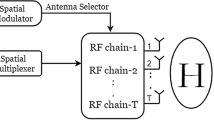Abstract
A number of studies recently have proposed optical spatial modulation (SM) as a simple, power- and bandwidth efficient modulation scheme for free-space optical communication (FSO) systems. In these studies, it was assumed that an active laser source only sends the signal to one targeted photodetector (PD). However, undesirable PDs still can receive the signal from the active source due to geometric spreading (i.e., laser beam broadening). In addition, if the fading channels between the active source and multiple PDs are correlated, the probability of wrong detection of the active source’s index during spatial demodulation process may increase. In this paper, we first analyze the impact of geometric spreading on the performance of FSO systems using SM over uncorrelated Gamma–Gamma fading channel. We find that the advantage in reducing the transmission bandwidth of SM cannot compensate its limitation in suffering from geometric spreading. We then propose to combine N-SM with pulse-position modulation (L-PPM) and transmit diversity (\(M\,\times \,1\) MISO) to improve the performance of SM-based FSO systems. The numerical results, which are validated by Monte–Carlo simulations, confirm the superiority of the proposed system in comparison with the conventional ones.







Similar content being viewed by others
References
Willebrand, H.A., Ghuman, B.S.: Fiber optics without fiber. IEEE Spectr. 38(8), 40–45 (2001). doi:10.1109/6.938713
Liu, Q., Qiao, C., Mitchell, G., Stanton, S.: Optical wireless communication networks for first- and last-mile broadband access [Invited]. OSA J. Opt. Netw. 4(12), 807–828 (2005). doi:10.1364/JON.4.000807
Zhu, X., Khan, J.M.: Free-space optical communication through atmospheric turbulence channels. IEEE Trans. Commun. 50(8), 1293–1300 (2002). doi:10.1109/TCOMM.2002.800829
Wilson, S.G., Brandt-Pearce, M., Cao, Q., Leveque, J.H.: Free-space optical MIMO transmission with Q-ary PPM. IEEE Trans. Commun. 53(8), 1402–1412 (2005). doi:10.1109/TCOMM.2005.852836
Cvijetic, N., Wilson, S.G., Brandt-Pearce, M.: Receiver optimization in turbulent free-space optical MIMO channels With APDs and Q-ary PPM. IEEE Photonics Technol. Lett. 19(2), 103–105 (2007). doi:10.1109/LPT.2006.889105
Bayaki, E., Schober, R., Mallik, R.K.: Performance analysis of MIMO free-space optical systems in Gamma–Gamma fading. IEEE Trans. Commun. 57(11), 3415–3424 (2009). doi:10.1109/TCOMM.2009.11.080168
Fath, T., Renzo, M.D., Haas, H.: On the performance of space shift keying for optical wireless communications. In: Proceedings of IEEE Globecom 2010, Miami, pp. 990–994 (2010). doi:10.1109/GLOCOMW.2010.5700474
Fath, T., Haas, H., Di Renzo, M., Mesleh, R.: Spatial modulation applied to optical wireless communications in indoor LOS environments. In: Proceedings of IEEE Globecom 2011, Houston (2011). doi:10.1109/GLOCOM.2011.6133552
Mesleh, R., Elgala, H., Haas, H.: Optical spatial modulation. IEEE/OSA J. Opt. Commun. Netw. 3(3), 234–244 (2011). doi:10.1364/JOCN.3.000234
Popoola, W.O., Poves, E., Haas, H.: Spatial pulse position modulation for optical communications. IEEE J. Lightwave Technol. 30(18), 2948–2954 (2012). doi:10.1109/JLT.2012.2208940
Popoola, W.O., Poves, E., Haas, H.: Error performance of generalised space shift keying for indoor visible light communications. IEEE Trans. Commun. 61(5), 1968–1976 (2013). doi:10.1109/TCOMM.2013.022713.120501
Hwang, S.H., Cheng, Y.: SIM/SM-aided free-space optical communication with receiver diversity. IEEE J. Lightwave Technol. 32(14), 2443–2450 (2014). doi:10.1109/JLT.2014.2327078
Ozbilgin, T., Koca, M.: Optical spatial modulation over atmospheric turbulence channels. IEEE J. Lightwave Technol. 33(11), 2313–2323 (2015). doi:10.1109/JLT.2015.2409302
Pham, H.T.T., Chu, D.B., Dang, N.T.: Performance analysis of spatial PPM-based free-space optical communication systems with Gaussian beam. In: Proceeding of the 2014 International Conference on Advanced Technology for Communication (ATC 2014), Hanoi, Vietnam, 144–148 (2014). doi:10.1109/ATC.2014.7043373
Bithas, P.S., Sagias, N.C., Mathiopoulos, P.T., Karagiannidis, G.K., Rontogiannis, A.A.: On the performance analysis of digital communications over generalized-K fading channels. IEEE Commun. Letters. 10(5), 353–355 (2006). doi:10.1109/LCOMM.2006.05030
Al-Habash, M.A., Andrews, L.C., Phillips, R.L.: Mathematical model for the irradiance probability density function of a laser beam propagating through turbulent media. Opt. Eng. 40(8), 1554–1562 (2001). doi:10.1117/1.1386641
Gradshteyn, I.S., Ryzhik, I.M.: Table of Integrals, Series, and Products, 7th edn. Academic, New York (2007)
Ricklin, J.C., Davidson, F.M.: Atmospheric turbulence effects on a partially coherent Gaussian beam: implications for free space laser communication. J. Opt. Soc. Am. A Opt. Image Sci 19(9), 1794–1802 (2002). doi:10.1364/JOSAA.19.001794
Farid, A.A., Hranilovic, S.: Outage capacity optimization for free-space optical links with pointing errors. IEEE J. Lightwave Technol. 25(7), 1702–1710 (2007). doi:10.1109/JLT.2007.899174
Chatzidiamantis, N.D., Karagiannidis, G.K.: On the distribution of the sum of gamma–gamma variates and applications in RF and optical wireless communications. IEEE Trans. Commun. 59(5), 1298–1308 (2011). doi:10.1109/TCOMM.2011.020811.090205
Dang, N.T., Pham, A.T.: Performance improvement of FSO/CDMA systems over dispersive turbulence channel using multi-wavelength PPM signaling. OSA Opt. Express 20(24), 26786–26797 (2012). doi:10.1364/OE.20.026786
Acknowledgements
The authors would like to thank the reviewers for their thorough reviews and useful suggestions for improving the readability of this paper. This research is funded by Vietnam National Foundation for Science and Technology Development (NAFOSTED) under the Grant No. 102.02-2015.06.
Author information
Authors and Affiliations
Corresponding author
Rights and permissions
About this article
Cite this article
Pham, H.T.T., Dang, N.T. Performance improvement of spatial modulation-assisted FSO systems over Gamma–Gamma fading channels with geometric spreading. Photon Netw Commun 34, 213–220 (2017). https://doi.org/10.1007/s11107-017-0685-0
Received:
Accepted:
Published:
Issue Date:
DOI: https://doi.org/10.1007/s11107-017-0685-0




